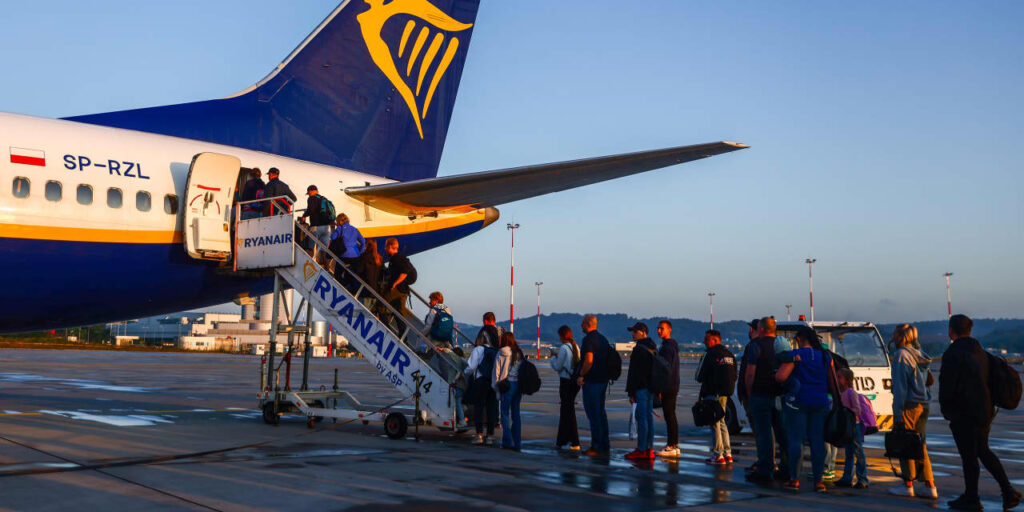U.S. low-cost airlines are under mounting pressure and, despite heavy losses, the stocks are best avoided.
But outside of the U.S. the model is looking healthier, and investors may want to consider using the recent stock market weakness as an opportunity to buy long-term low-cost winners. One such name is
Ryanair
(ticker: RYAAY)—the dominant discount carrier in Europe.
A miserable combination of factors has conspired to hammer America’s low-cost and ultra-low-cost airline stocks in recent months. Rising oil prices, elevated labor costs and softening domestic demand mean it’s difficult to see a recovery soon.
The way low-cost airlines would typically counter such cost pressures is by increasing flying hours, also known as block hours, and filling up their planes. They can’t really increase fares, as the network carriers can, given their business model is to offer low fares.
But for many reasons, they haven’t been able to fly enough to offset those factors.
“Domestic markets are facing harder comps, we also have an air-traffic control situation with not enough FAA workers, and that makes it hard for the discount airlines to reach the block hour utilization they need to consistently maintain their profitability,” Citi analyst Stephen Trent told Barron’s. He added that global supply-chain problems, including with aircraft delivery and engines, compounded matters.
Contrasting Carriers
In contrast, the network carriers—
United Airlines,
Delta Air Lines,
and
American Airlines
have comfortably returned to profitability since the Covid-19 pandemic—aided by a shift to premium economy travel and surging international demand.
“We can’t recall a time when results were as widely bifurcated between the margin haves and the have-nots…unless we go back to post 9/11 when it was the discounters on top,” J.P. Morgan analyst Jamie Baker said.
It’s hard to see that gap closing in the coming quarters. Wall Street expects
Spirit Airlines
(SAVE) to post six consecutive quarterly losses beginning with its third-quarter results Wednesday, and both
Frontier Group
(ULCC) and
JetBlue Airways
(JBLU) to embark on a losing streak of three quarters. Southwest, the largest low-cost flier, may have more joy—with analysts expecting five of the next six quarters to be profitable.
It’s been a bad year for America’s low-cost and ultra-low-cost names.
Southwest Airlines
(LUV) is down 28%, JetBlue 32%, Frontier 58%, and Spirit has fallen 17%. Losses on that scale can sometimes be buying opportunities, but that’s not the case right now.
Citi analysts removed their last remaining Buy rating on a U.S. low-cost carrier last month, downgrading Frontier to Neutral. Trent said it was tough to see the picture improving in the fourth quarter, adding that oil prices and labor costs were “going the wrong way.”
“The model is under pressure but is it dead and buried? I would say no,” Trent noted. “What’s going on in the U.S. isn’t necessarily going on in other countries.”
Ryanair Resilience
Indeed, the picture is slightly brighter in Europe, where low-cost carriers don’t have things quite so bad.
Firstly, it’s a different market entirely and one that easily lends itself to short-haul flying due to geography in that distances to destinations are shorter. Secondly, Europe has found it far easier to solve its postpandemic pilot shortage—the European Union requires pilots to fly 250 training hours, compared with the FAA’s 1,500-hour rule. This means more pilots can enter the workforce faster.
Given there’s greater pilot availability in Europe, industry pay levels have not jumped to the same extent as in the U.S., where a lack of aviators has been a key bargaining chip for pilot unions. Therefore, European airlines are not battling the same labor cost pressures as their American counterparts.
European names have still fallen in tandem with their U.S. counterparts.
Ryanair’s
American depositary receipts (ADRs) have dropped 19% since their July peak.
But that’s made the shares look attractive. The stock is currently trading at 7.7 times forward earnings, the cheapest it has ever been since listing in 1997. The Dublin-headquartered airline group’s ADRs have a rare 100% Buy rating among analysts. The average target price is $147.92, implying 64% upside to Thursday’s closing price.
For Ryanair, the cyclical factors, such as elevated fuel costs, will pass and when they do the company is likely to emerge in an even stronger position. “Generally, sometimes bad news is good news for Ryanair. If it’s really hard for those marginal players to operate they have to pull down capacity and Ryanair gets to take market share,” Raymond James analyst Savanthi Syth told Barron’s.
The stock has pulled back too much in recent months, she added, and Ryanair has the balance sheet to withstand the current challenges. Syth has a Buy rating on the stock with a price target of $140.
Prime Position
Its industry-leading cost base means it’s able to lower fares this winter to stimulate demand, and snatch more market share from its rivals.
The airline has ambitious plans to carry 300 million passengers a year by 2034, up from 169 million in the year ending March 2023. Its order of 300 Boeing Max-10 aircraft, to be delivered between 2027 and 2033 is a big part of how it intends to reach that goal.
Growing market share is another part of that puzzle. For example, Ryanair wants to increase it in Italy to 50% from 38%, and said 50 additional planes were needed to make that happen. It has similar targets in several other European countries and is also eyeing growth in new markets including Albania, North Africa, and Ukraine.
CEO Michael O’Leary predicted last year that Ryanair would eventually be the only low-cost carrier in Europe, as the region moves closer to the U.S. ‘Big Four’ setup—three larger airlines and one large discounter.
While it’s worth taking that with a pinch of salt, Ryanair is undoubtedly in a position to strengthen its dominance.
Write to Callum Keown at [email protected]
Read the full article here



